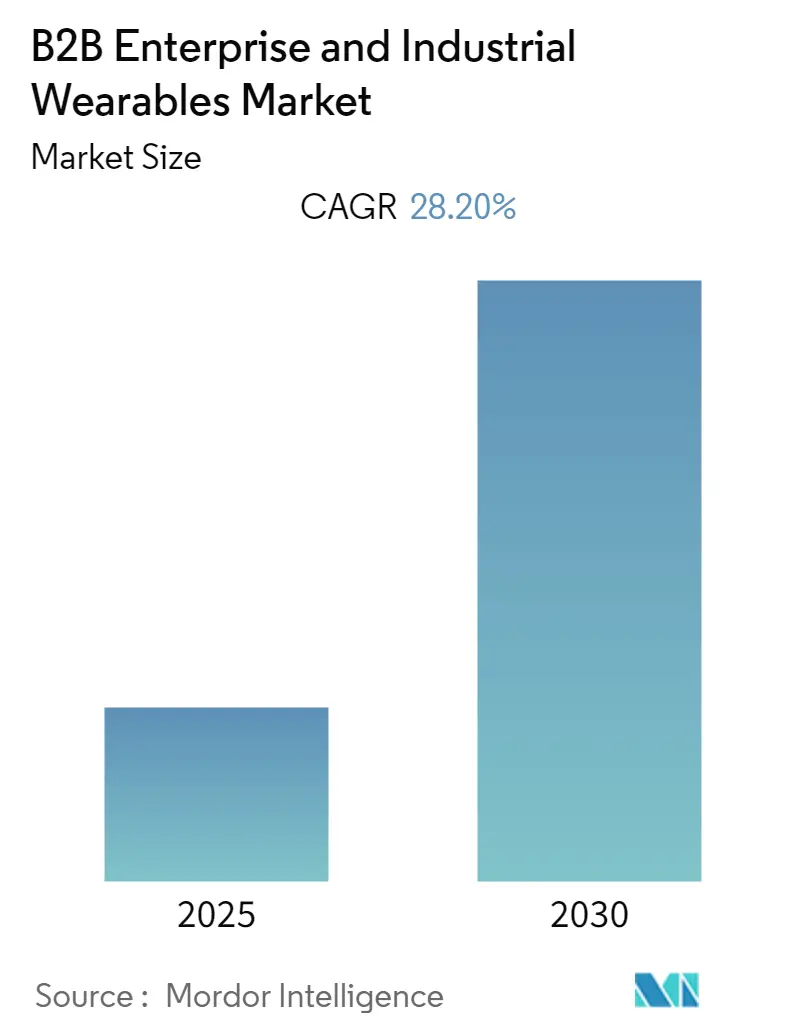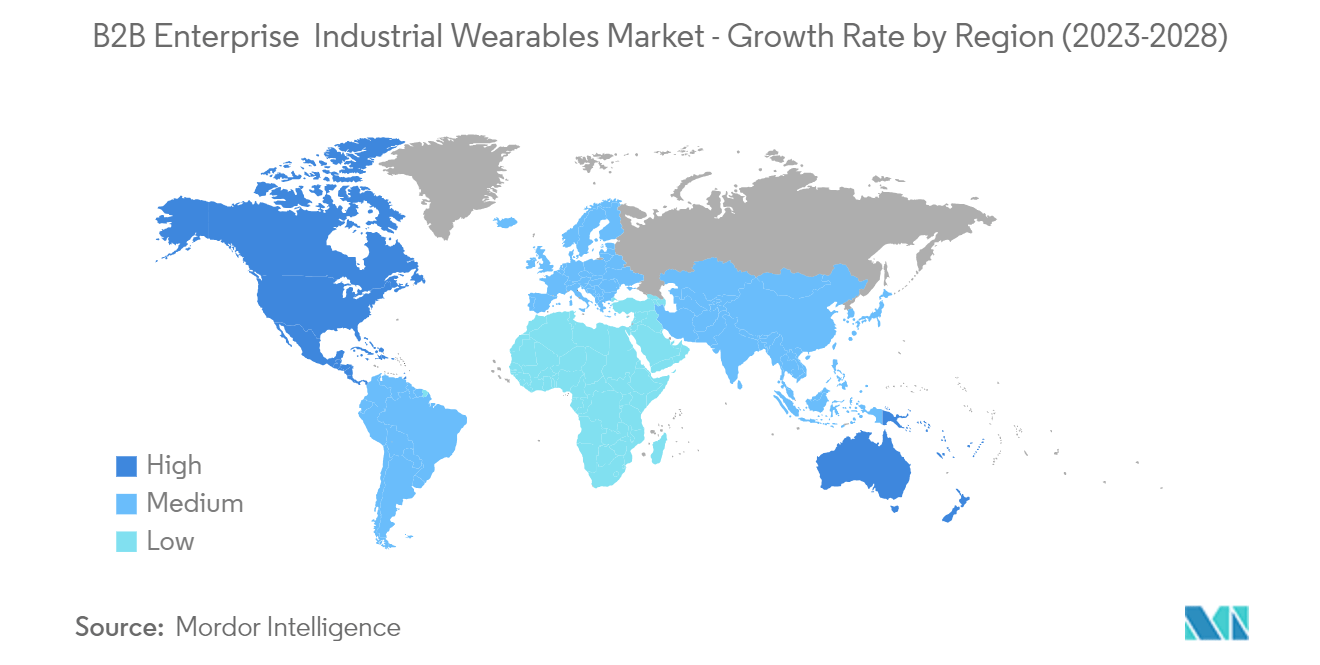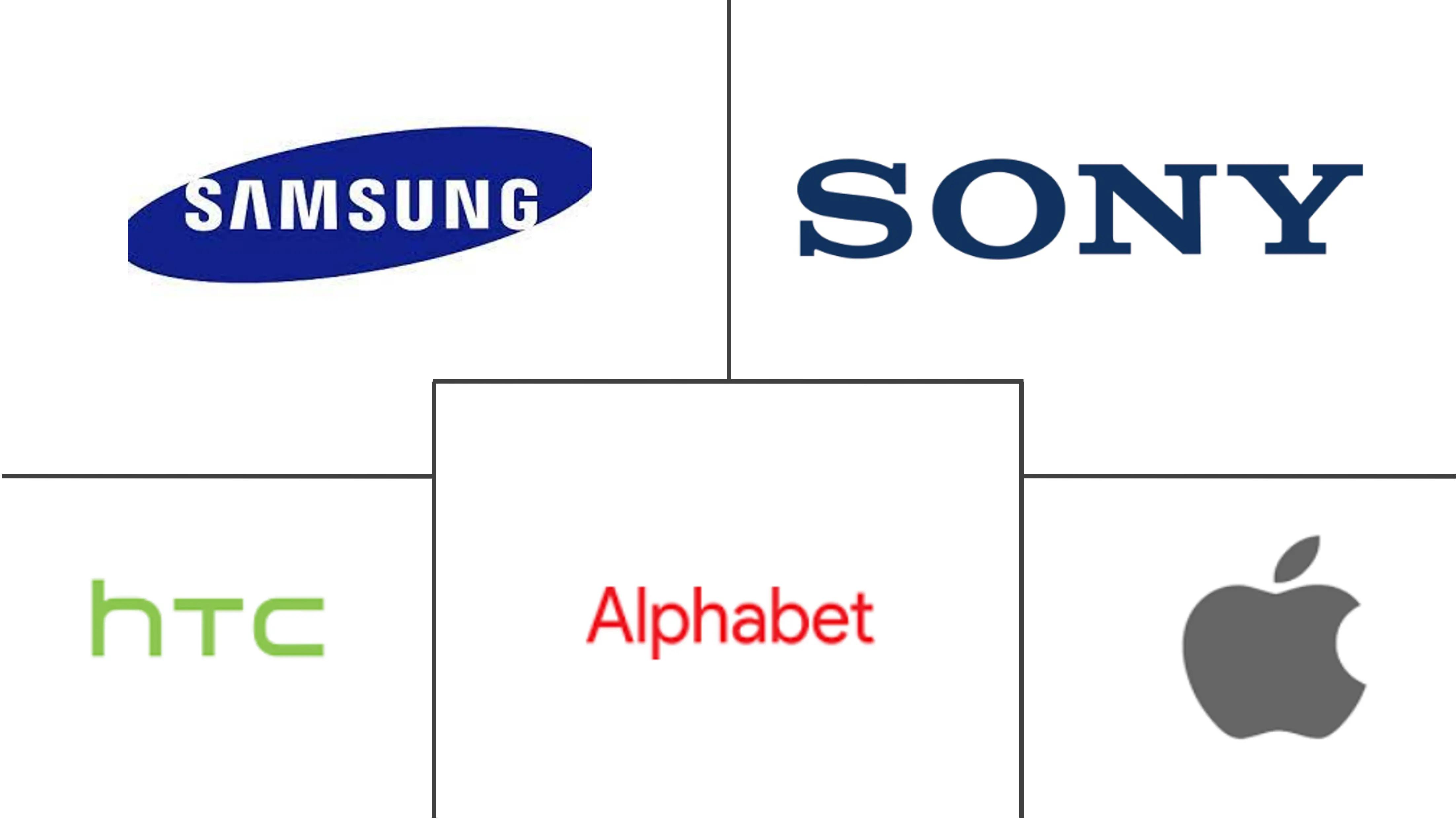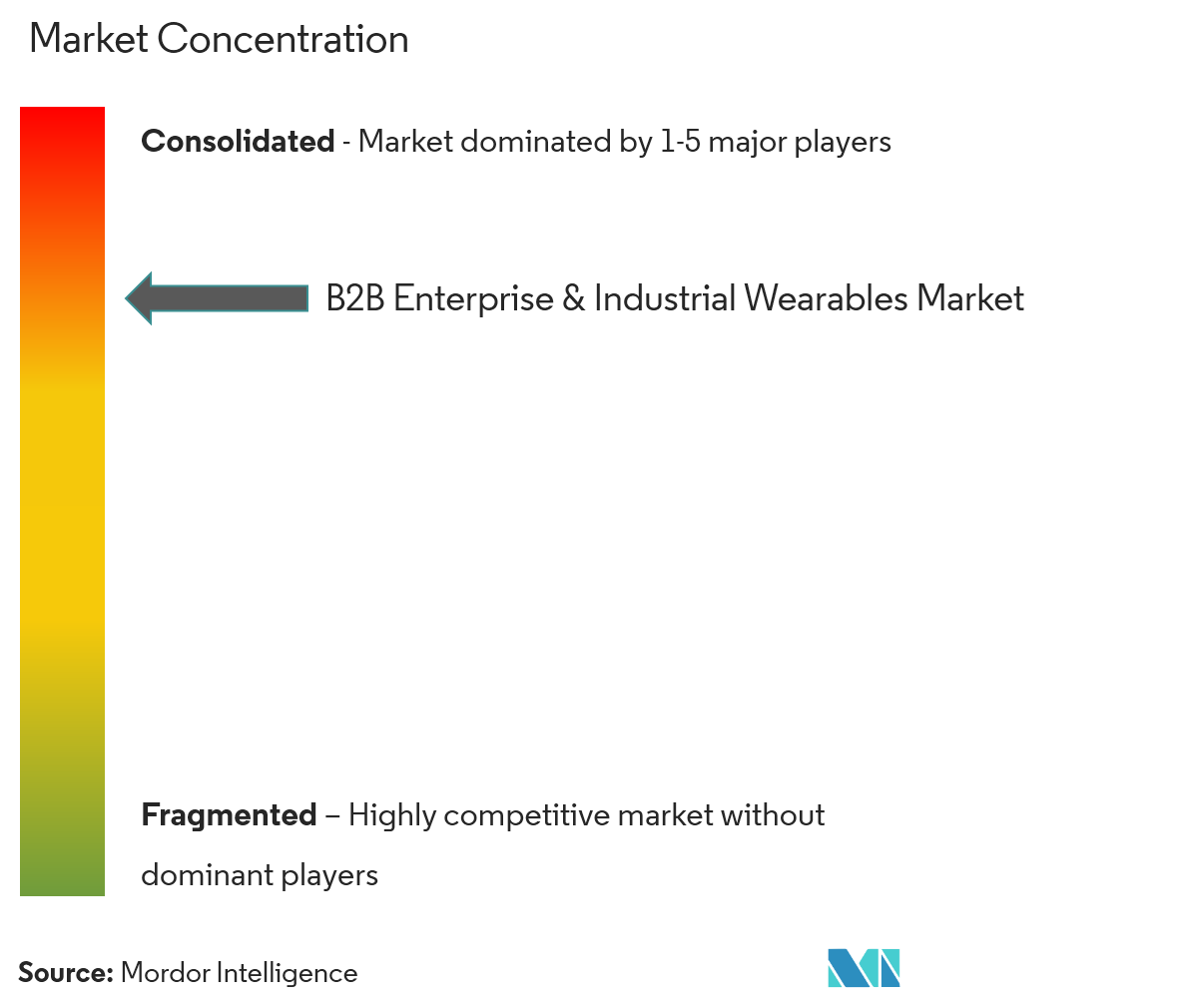
B2B Enterprise & Industrial Wearables Market Analysis
The B2B Enterprise & Industrial Wearables Market is expected to register a CAGR of 28.2% during the forecast period.
- The wearables market in an enterprise setup is in its infancy, with a significant share of the applications designated to enhancing customer experience. Wearables are extensively used to access customer data in real-time, view business analytics, and produce immersive customer experiences, factory operations, and training.
- Global enterprise IT organizations have now recognized the benefits of wearables, thereby developing and providing businesses with a way to automate the deployment of modern applications at scale, which drives the demand for enterprise adoption with the growing mobile app ecosystem. Mobile apps can build loyal customer bases, provide insightful customer data, and more. Businesses should understand how these apps can enhance CX, especially if they maintain close contact with customers or business partners.
- The demand for smart factory setups aids the growth of the wearables market. Governments worldwide are becoming aware of the significant potential of innovative manufacturing technologies. Therefore, they support and fund R&D for technologies such as IIoT and expect to become potential adopters of the technology and private firms. They financially support new IoT projects and implementations to build and run smart factory setups.
- Technical obstacles such as longer operating times, which are currently constrained by battery life and the limitations of other power sources, the balance between faster data transmission (for real-time operations) and low power consumption, weight reduction, and biocompatibility are expected to hinder the growth of B2B wearables. Data privacy concerns may slow the adoption of wearables in the B2B setup, where sensitive data is circulated through a network of wearables.
- The COVID-19 pandemic highly impacted the wearables market. The global prices of consumer electronics witnessed a rise initially owing to the partial clampdown on manufacturing facilities; critical components such as NFC chips and RFID tags faced a slowdown in their supply chain. However, the market was positively impacted post-pandemic, accelerating the rise of the digital economy, particularly wearable devices such as smartwatches.
B2B Enterprise & Industrial Wearables Market Trends
Demand for Smart Factory Setups are Expected to Aid Growth of Wearables
- Industrial wearables are being increasingly used due to the steady decline in component costs and improvements in functionality driven by learnings from the consumer sector. Industrial wearables increase efficiency, improve safety, shorten communication loops, accelerate onboarding and training processes, and enable remote experts to discuss technical issues.
- Unfortunately, training is very hands-off by nature, especially in the manufacturing sector. This is because inexperience can lead to severe equipment damage, injuries, or poor performance. Employers can leverage wearable technology to make this age-old process modern and efficient. General Motors, for instance, leveraged Google Glass, an augmented reality glass, to provide a unique, improved training process for its employees.
- According to the International Labor Organization, every 15 seconds, 151 workers have a work-related accident. ILO further divulged that yearly, at least 317 million workers have non-fatal occupational accidents worldwide. With wearable and embedded sensors, workers can be tracked to prevent injury from falls, heavy machinery, or overexertion. In the future, manufacturing units are expected to leverage the rise of IoT and connected machinery to make workplaces safer. Smart glasses with Augmented Reality (AR) are expected to be the next big thing in manufacturing facilities.
- IBM is working with North Star BlueScope Steel, a global building and construction industry steel producer, to develop a cognitive platform to ensure employees stay safer at workplaces. The system uses IBM Watson IoT for wearable safety technology. The technology, a part of the IBM Employee Wellness and Safety Solution, gathers data from sensors embedded in helmets and wristbands and analyzes it to alert employees and their managers in real time.
- Wearable devices for hands-free instructions and communication is a straightforward, practical application of the technology. For instance, oil, gas, and automotive workers often need to give complicated, documented instructions. Since there is no audit trail for these kinds of education, with paper, it is not easy to know whether instructions have been followed correctly or not. The software product that Intoware now has, WorkfloPlus, allows employees to use apps on different devices (wearables, smartphones, tablets, etc.) to provide reliable information to show that a process has been followed properly.

North America is Expected to hold the Major Market Share for B2B and Industrial Wearables
- North America is expected to hold the largest market share for B2B & Industrial Wearables because of the adoption of the technology, penetration of the internet, and government expenditure on research leading to the development of technology for high-end applications like the military.
- North America has the presence of prominent market players who offer wearable devices at a low price, making them affordable for customers. Many international players get their wearable devices manufactured and assembled by local manufacturers based in the region and then brand their names. The US and Canada account for the high adoption rate of consumer electronics. For instance, in the United States, BMW has been using smart glasses for inspection checking and quality assurance of its cars. The company's pilot allowed inspectors to take data through photos and videos to document potential deviations in production quality, allowing BMW to get rid of paper-based quality assurance checks, making the reviews efficient, and providing more contextual information related to the statements.
- Wearable device manufacturers continuously innovate their wearable devices to attain a competitive advantage. Several manufacturers have integrated NFC technology into their wearable devices to enable payment functionalities. Also, the improved standard of living has led to a growing demand for wearable devices in this region.
- According to CISCO, in the United States, there are expected to be 327 million total Internet users (94% of the population) by 2023, up from 307 million (92% of the population) in 2022. 32% of all networked devices are expected to be mobile-connected by the end of 2022, which drives the demand for the Wearables Market.
- The future of military combat is expected to be high-tech as scientists use the Internet of Things for combat gear integrated with biometric wearables to help soldiers identify the enemy, perform better in battle, and access devices and weapons systems using edge computing. The United States Army Research Lab recently awarded USD 25 million to the Alliance for the Internet of Battlefield Things Research on Evolving Intelligent Goal-driven Networks (IoBT REIGN) to develop new predictive battlefield analytics. The US Govt remains one of the largest investors and consumers of such technology leading to the proliferation of technology in the region.

B2B Enterprise & Industrial Wearables Industry Overview
The B2B Enterprise & Industrial Wearables Market is consolidated, with a few players dominating the market. However, the proliferation of the technology that will reduce its cost and its increased applications in the labor-intensive service sector is expected to increase the market size. This is expected to attract several players into this market in the future.
In May 2022, B2B unicorn Zetwerk commissioned a state-of-the-art original design manufacturing (ODM) facility for hearables, wearables, and IoT (internet of things) devices in Noida. The Noida facility is spread over 50,000 square feet and comprises 16 manufacturing lines with advanced testers and an innovation lab for product development.
Additionally, in January 2022, Neurala, a leading vision AI software company, announced the launch of its new detection technology aimed at improving quality inspection at smart factories. Manufacturers strive to optimize their smart manufacturing lines via innovative solutions and technologies.
B2B Enterprise & Industrial Wearables Market Leaders
-
Alphabet Inc.
-
Samsung Electronics Co. Ltd.
-
Sony Corporation
-
HTC Corporation
-
Apple Inc
- *Disclaimer: Major Players sorted in no particular order
B2B Enterprise & Industrial Wearables Market News
- Sept 2022: Amazfit, a leading global smart wearables brand of Zepp Health, teamed up with digital health partner Adidas Runtastic to motivate the diverse international athletic community through industry-leading workout tracking and sharing using Amazfit's proprietary multi-generation BioTracker PPG biometric tracking optical sensor technology, which allows users to monitor a comprehensive range of health and fitness metrics accurately.
- Jun 2022: Mensa Brands acquired India's smart wearable brand Pebble, which offers audio products, fitness products, and charging solutions and has offline distribution.
B2B Enterprise & Industrial Wearables Industry Segmentation
Wearable technology consists of devices that use wearable sensors to track data about self-monitoring, personal responsibility, and creating awareness about the operating surroundings of an employee. Industrial wearable devices are designed to improve workplace productivity, safety, and efficiency in sectors like manufacturing, logistics, and mining. These devices collect data in real time, track activities, provide alerts, and provide customized experiences depending on the needs of the users and organizational objectives. They are designed for specific situations or industry verticals against consumer wearables, which are often general in function.
The B2B Enterprise and industrial Wearables Market is Segmented by Device Type (HMDs, Wrist Wears, Enterprise Smart Glass, Wearable Cameras, and Other Device Types), End-user Industry (IT and Telecom, Healthcare, Retail, Insurance, Manufacturing, Other End-user Industries), and Geography (North America, Europe, Asia-Pacific, and the Rest of the World). The market sizes and forecasts are provided in terms of value (USD) for all the above segments.
| By Device Type | HMDs |
| Wrist Wears (Smart Watch and Fitness Bands) | |
| Enterprise Smart Glass | |
| Smart Clothing and Body Sensors | |
| Wearable Cameras | |
| Other Device Types | |
| By End-user Industry | IT and Telecom |
| Healthcare | |
| Retail | |
| Insurance | |
| Manufacturing | |
| Other End-user Industries | |
| By Geography | North America |
| Europe | |
| Asia-Pacific | |
| Rest of the World |
B2B Enterprise & Industrial Wearables Market Research FAQs
What is the current B2B Enterprise & Industrial Wearables Market size?
The B2B Enterprise & Industrial Wearables Market is projected to register a CAGR of 28.2% during the forecast period (2025-2030)
Who are the key players in B2B Enterprise & Industrial Wearables Market?
Alphabet Inc., Samsung Electronics Co. Ltd., Sony Corporation, HTC Corporation and Apple Inc are the major companies operating in the B2B Enterprise & Industrial Wearables Market.
Which is the fastest growing region in B2B Enterprise & Industrial Wearables Market?
Asia Pacific is estimated to grow at the highest CAGR over the forecast period (2025-2030).
Which region has the biggest share in B2B Enterprise & Industrial Wearables Market?
In 2025, the North America accounts for the largest market share in B2B Enterprise & Industrial Wearables Market.
What years does this B2B Enterprise & Industrial Wearables Market cover?
The report covers the B2B Enterprise & Industrial Wearables Market historical market size for years: 2019, 2020, 2021, 2022, 2023 and 2024. The report also forecasts the B2B Enterprise & Industrial Wearables Market size for years: 2025, 2026, 2027, 2028, 2029 and 2030.
Our Best Selling Reports
B2B Enterprise & Industrial Wearables Industry Report
Statistics for the 2025 B2B Enterprise & Industrial Wearables market share, size and revenue growth rate, created by Mordor Intelligence™ Industry Reports. B2B Enterprise & Industrial Wearables analysis includes a market forecast outlook for 2025 to 2030 and historical overview. Get a sample of this industry analysis as a free report PDF download.




